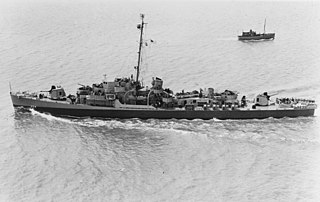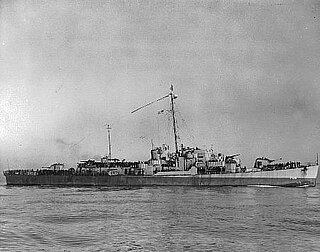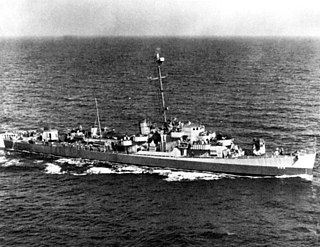
USS Rudderow (DE-224) was the lead ship of her class of destroyer escorts, in service with the United States Navy from 1944 to 1947. After spending decades in reserve, she was sold for scrap in 1970.

USS Stevens (DD-479) was a Fletcher-class destroyer in service with the United States Navy from 1943 to 1946. She was finally sold for scrap in 1973.

USS Foote (DD-511), a Fletcher-class destroyer, was the third ship of the United States Navy to be named for Rear Admiral Andrew Hull Foote (1806–1863), who served during the Civil War.

The fourth USS Flusser (DD-368) was a Mahan-class destroyer in the United States Navy before and during World War II. She was named for Charles W. Flusser.

USS Dufilho (DE-423), was a John C. Butler-class destroyer escort.

USS Holt (DE-706) was a Rudderow-class destroyer escort of the United States Navy. She was named after William Mack Holt.

The USS Culebra Island (ARG-7) was a Luzon-class internal combustion engine repair ship in the service of the United States Navy in World War II. Named after Culebra, an island between Puerto Rico and the Virgin Islands, it was the only ship of the Navy to bear this name.

USS Manning (DE-199) was a Buckley-class destroyer escort in service with the United States Navy from 1943 to 1947. She was scrapped in 1969.

USS Newman (DE-205/APD-59) was a Buckley-class destroyer escort in service with the United States Navy from 1943 to 1946. She was scrapped in 1966.

USS Lloyd (DE-209/APD-63), a Buckley-class destroyer escort of the United States Navy, was named in honor of Ensign William R. Lloyd (1916–1942).

USS Daniel A. Joy (DE-585) was a Rudderow-class destroyer escort in service with the United States Navy from 1944 to 1965. She was scrapped the following year.

USS Jesse Rutherford (DE-347) was a John C. Butler-class destroyer escort acquired by the United States Navy during World War II and named in honor of Private Jesse Rutherford Jr., USMC. Her primary purpose was to escort and protect ships in convoys; other tasks assigned included patrol and radar picket. Post-war, she returned home with one battle star to her credit.

USS Key (DE-348) was a John C. Butler-class destroyer escort in service with the United States Navy from 1944 to 1946. She was scrapped in 1972.

USS Gentry (DE-349) was a John C. Butler-class destroyer escort acquired by the U.S. Navy during World War II. The primary purpose of the destroyer escort was to escort and protect ships in convoy, in addition to other tasks as assigned, such as patrol or radar picket.

USS George E. Davis (DE-357) was a John C. Butler-class destroyer escort acquired by the U.S. Navy during World War II. The primary purpose of the destroyer escort was to escort and protect ships in convoy, in addition to other tasks as assigned, such as patrol or radar picket.

USS Edmonds (DE-406) was a John C. Butler-class destroyer escort in service with the United States Navy from 1944 to 1946 and from 1951 to 1965. She was scrapped in 1973.

USS Leland E. Thomas (DE-420) was a John C. Butler-class destroyer escort in service with the United States Navy from 1944 to 1946. She was scrapped in 1973.

USS Day (DE-225) was a Rudderow-class destroyer escort in the United States Navy during World War II.

USS Chaffee (DE-230) was a Rudderow-class destroyer escort in the United States Navy during World War II.

USS Tinsman (DE-589) was a Rudderow-class destroyer escort in service with the United States Navy from 1944 to 1946. She was sold for scrapping in 1973.




















